"As minhas palavras têm memórias ____________das palavras com que me penso, e é sempre tenso _________o momento do mistério inquietante de me escrever"
segunda-feira, 29 de fevereiro de 2016
HISTÓRIA DE PORTUGAL: in Wikipédia, a Batalha de Aljubarrota
Batalha de Aljubarrota
Origem: Wikipédia, a enciclopédia livre.
Coordenadas:
 39º38'17"N 8º50'42"O
39º38'17"N 8º50'42"OBatalha de Aljubarrota
Crise de 1383-1385
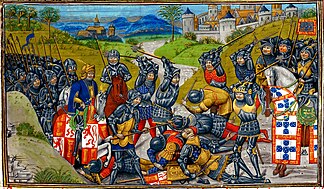
Data 14 de agosto de 1385
Local Campo de São Jorge, Calvaria de Cima, perto de Aljubarrota, Portugal
Desfecho Vitória decisiva de Portugal
Combatentes
 Reino de Portugal
Reino de Portugal Reino da Inglaterra
Reino da Inglaterra  Castela
Castela Reino de França
Reino de França Reino de Aragão(aliados)
Reino de Aragão(aliados)Italianos (aliados)
Comandantes
 João I de Portugal
João I de Portugal Nuno Álvares Pereira
Nuno Álvares Pereira  João I de Castela
João I de Castela Pedro Álvares Pereira
Pedro Álvares PereiraForças
Cerca de 6,500 homens:
4,000 peões;
1,700 lanceiros;
800 besteiros;
100 arqueiros ingleses. Cerca de 31,000 homens:
15,000 peões;
6,000 lanceiros;
8,000 besteiros;
Mais de 2.000 cavaleiros pesados franceses;
15 morteiros.
Baixas
1,000< 4,000 a 5,000; 5000, no rescaldo.
A Batalha de Aljubarrota decorreu no final da tarde de 14 de agosto de 1385 entre tropas portuguesas com aliados ingleses, comandadas por D. João I de Portugal e o seu condestável D. Nuno Álvares Pereira, e o exército castelhano e seus aliados liderados por D. João I de Castela. A batalha deu-se no campo de São Jorge, pertencente à freguesia de Calvaria de Cima, concelho de Porto de Mós, nas imediações da vila de Aljubarrota, entre o referido concelho eAlcobaça[1] .
O resultado foi uma derrota definitiva dos castelhanos, o fim da crise de 1383-1385 e a consolidação de D. João I, Mestre de Avis, como rei de Portugal, o primeiro da Dinastia de Avis. A aliança Luso-Britânica saiu reforçada desta batalha e seria selada um ano depois, com a assinatura do Tratado de Windsor e o casamento do rei D. João I com D. Filipa de Lencastre. Como agradecimento pela vitória na Batalha de Aljubarrota, D. João I mandou edificar o Mosteiro da Batalha. A paz com Castela só viria a estabelecer-se em 1411 com o Tratado de Ayllón, ratificado em 1423.
A Batalha de Aljubarrota foi uma das raras grandes batalhas campais da Idade Média entre dois exércitos régios e um dos acontecimentos mais decisivos da história de Portugal. Inovou a tática militar, permitindo que homens de armas apeados fossem capazes de vencer uma poderosa cavalaria. No campo diplomático, permitiu a aliança entre Portugal e a Inglaterra, que perdura até hoje. No aspecto político, resolveu a disputa que dividia o Reino de Portugal do Reino de Castela e Leão, permitindo a afirmação de Portugal como Reino Independente, abrindo caminho sob a Dinastia de Avis para uma das épocas mais marcantes da história de Portugal, a era dos Descobrimentos.
Directamente associada à vitória dos portugueses nesta batalha, celebrizou-se a figura lendária da heroína Brites de Almeida, mais conhecida como "aPadeira de Aljubarrota", que com a sua pá terá morto sete castelhanos que encontrara escondidos no seu forno.
Índice [esconder]
1Antecedentes
2Disposição da hoste portuguesa
3A chegada dos castelhanos
4A batalha
5O dia seguinte
6Ver também
7Bibliografia
8Referências
9Ligações externas
Antecedentes[editar | editar código-fonte]
No fim do século XIV, a Europa encontrava-se a braços com uma época de crise e revolução. A Guerra dos Cem Anos devastava a França, epidemias depeste negra levavam vidas em todo o continente, a instabilidade política dominava e Portugal não era exceção.
Em 1383, El-rei D. Fernando morreu sem um filho varão, que herdasse a coroa. A sua única filha era a infanta D. Beatriz, casada com o rei D. João I de Castela. A burguesia mostrava-se insatisfeita com a regência da Rainha D. Leonor Teles e do seu favorito, o conde Andeiro e com a ordem da sucessão, uma vez que isso significaria anexação de Portugal por Castela. As pessoas alvoroçaram-se em Lisboa, o conde Andeiro foi morto e o povo pediu ao mestre de Avis, D. João, filho natural de D. Pedro I de Portugal, que ficasse por regedor e defensor do Reino.
O período de interregno que se seguiu ficou conhecido como crise de 1383-1385. Finalmente a 6 de Abril de 1385, D. João, mestre da Ordem de Avis, é aclamado rei pelas cortes reunidas em Coimbra, mas o rei de Castela não desistiu do direito à coroa de Portugal, que entendia advir-lhe do casamento.
Perante a revolta da população portuguesa em vários pontos e cidades do Reino de Portugal, o Rei de Castela, decide em 1384 entrar em Portugal. Entre Fevereiro e Outubro deste ano monta um cerco a Lisboa, por terra e por mar.
Uma frota portuguesa vinda do Porto enfrenta, a 18 de Julho de 1384, à entrada de Lisboa, a frota castelhana, na batalha do Tejo. Os portugueses perdem três naus e sofrem vários prisioneiros e mortos; no entanto, a frota portuguesa consegue romper a frota castelhana, que era muito superior, e descarregar no porto de Lisboa os alimentos que trazia. Esta ajuda alimentar veio-se a revelar muito importante para a população que defendia Lisboa.
O cerco de Lisboa pelas tropas castelhanas acaba por não resultar, devido à determinação das forças portuguesas em resistir ao cerco, ao facto de Lisboa estar bem murada e defendida, à ajuda dos alimentos trazidos do Porto e devido à epidemia de peste negra que assolou as forças castelhanas acampadas no exterior das muralhas.
Em Junho de 1385, D. João I de Castela decide invadir novamente Portugal, desta vez à frente da totalidade do seu exército e auxiliado por um forte contingente de cavalaria francesa.
Disposição da hoste portuguesa[editar | editar código-fonte]

Nuno Alvares Pereira a rezar antes da batalha, em azulejos de Jorge Colaço no Centro Cultural Rodrigues de Faria.
Quando as notícias da invasão chegaram, é reunido o conselho militar em Abrantes para decidir o que fazer. O rei decide invadir Castela pela zona de Sevilha para atrair o exército invasor. O condestável opõe-se e defende dar batalha para travar o passo ao inimigo; não se entendem e D. Nuno parte com a sua hoste para Tomar. O rei pensando melhor manda informar D. Nuno que estava de acordo com ele e encontram-se os dois em Tomar. Com os aliados ingleses, o exército português intercetou os invasores perto de Leiria. Dada a lentidão com que os castelhanos avançavam, D. Nuno Álvares Pereira teve tempo para escolher o terreno favorável para a batalha. A opção recaiu sobre uma pequena colina de topo plano rodeada por ribeiros, perto de Aljubarrota. Contudo o exército Português não se apresentou ao Castelhano nesse sítio, inicialmente formou as suas linhas noutra vertente da colina, tendo depois, já em presença das hostes castelhanas mudado para o sítio predefinido, isto provocou bastante confusão nas tropas de Castela.
Assim pelas dez horas da manhã do dia 14 de agosto, o exército tomou a sua posição na vertente norte desta colina, de frente para a estrada por onde os castelhanos eram esperados. A disposição portuguesa era a seguinte: infantaria no centro da linha, uma vanguarda de besteiros com os 200 archeiros ingleses, 2 alas nos flancos, com mais besteiros, cavalaria e infantaria. Na retaguarda, aguardavam os reforços e a cavalaria comandados por D. João I de Portugal em pessoa. Desta posição altamente defensiva, os portugueses observaram a chegada do exército castelhano protegidos pela vertente da colina.

Esquema ilustrando a Batalha de Aljubarrota.
A chegada dos castelhanos[editar | editar código-fonte]
A vanguarda do exército de Castela chegou ao teatro da batalha pela hora do almoço, sob o sol escaldante de agosto. Ao ver a posição defensiva ocupada por aquilo que considerava os rebeldes, o rei de Castela tomou a esperada decisão de evitar o combate nestes termos. Lentamente, devido aos 30 000 soldados que constituíam o seu efetivo, o exército castelhano começou a contornar a colina pela estrada a nascente. A vertente sul da colina tinha um desnível mais suave e era por aí que, como D. Nuno Álvares previra, pretendiam atacar.[1]
O exército português inverteu então a sua disposição e dirigiu-se à vertente sul da colina, onde o terreno tinha sido preparado previamente. Uma vez que era muito menos numeroso e tinha um percurso mais pequeno pela frente, o contingente português atingiu a sua posição final muito antes do exército castelhano se ter posicionado. D. Nuno Álvares Pereira havia ordenado a construção de um conjunto de paliçadas e outras defesas em frente à linha de infantaria, protegendo esta e os arqueiros. Este tipo de tática defensiva, muito típica das legiões romanas, ressurgia na Europa nessa altura.
Pelas seis da tarde, os castelhanos ainda não completamente instalados decidem, precipitadamente, ou temendo ter de combater de noite, começar o ataque.
É discutível se de facto houve a tão famosa tática do "quadrado" ou se simplesmente esta é uma visão imaginativa de Fernão Lopes de umas alas reforçadas. No entanto tradicionalmente foi assim que a Batalha acabou por seguir para a história.
A batalha[editar | editar código-fonte]
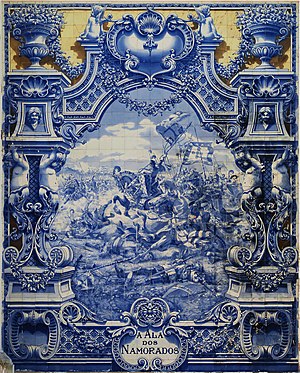
Painel de azulejos pintado por Jorge Colaço(1922) representando um episódio da batalha de Aljubarrota. No Pavilhão Carlos Lopes, Lisboa,Portugal.
O ataque começou com uma carga da cavalaria francesa: a toda a brida e em força, de forma a romper a linha de infantaria adversária.[1] Contudo as linhas defensivas portuguesas repeliram o ataque. A pequena largura do campo de batalha, que dificultava a manobra da cavalaria, as paliçadas (feitas com troncos erguidos na vertical separados entre si apenas pela distância necessária à passagem de um homem, o que não permitia a passagem de cavalos) e a chuva de virotes lançada pelos besteiros (auxiliados por 2 centenas de arqueiros ingleses comandados por Sir Leon Baade)[2] fizeram com que, muito antes de entrar em contacto com a infantaria portuguesa, já a cavalaria se encontrava desorganizada e confusa. As baixas da cavalaria foram pesadas e o efeito do ataque nulo.
Ainda não perfilada no terreno, a retaguarda castelhana demorou a prestar auxílio e, em consequência, os cavaleiros que não morreram foram feitos prisioneiros pelos portugueses.
Depois deste revés, a restante e mais substancial parte do exército castelhano atacou. A sua linha era bastante extensa pelo elevado número de soldados. Ao avançar em direção aos portugueses, os castelhanos foram forçados a apertar-se (o que desorganizou as suas fileiras) de modo a caber no espaço situado entre os ribeiros. Enquanto os castelhanos se desorganizavam, os portugueses redispuseram as suas forças, dividindo a vanguarda de D. Nuno Álvares em dois setores, de modo a enfrentar a nova ameaça. Vendo que o pior ainda estava para chegar, D. João I de Portugal ordenou a retirada dos besteiros e archeiros ingleses e o avanço da retaguarda através do espaço aberto na linha da frente.
Desorganizados, sem espaço de manobra e finalmente esmagados entre os flancos portugueses e a retaguarda avançada, os castelhanos pouco puderam fazer senão morrer. Ao pôr-do-sol, a batalha estava já perdida para Castela. Precipitadamente, D. João de Castela ordenou a retirada geral sem organizar a cobertura. Os castelhanos debandaram então desordenadamente do campo de batalha. A cavalaria Portuguesa lançou-se em perseguição dos fugitivos, dizimando-os sem piedade.
Alguns fugitivos procuraram esconder-se nas redondezas, apenas para acabarem mortos às mãos do povo.
Surge aqui uma tradição portuguesa em torno da batalha: uma mulher, de seu nome Brites de Almeida, recordada como a Padeira de Aljubarrota, iludiu, emboscou e matou pelas próprias mãos alguns castelhanos em fuga. A história é por certo uma lenda da época. De qualquer forma, pouco depois D. Nuno Álvares Pereira ordenou a suspensão da perseguição e deu trégua às tropas fugitivas.
O dia seguinte[editar | editar código-fonte]

Voto de D. João I a Nossa Senhora da Oliveira na Batalha de Aljubarrota.
Na manhã de 15 de agosto, a catástrofe sofrida pelos castelhanos ficou bem à vista: os cadáveres eram tantos que chegaram para barrar o curso dos ribeiros que flanqueavam a colina. Para além de soldados de infantaria, morreram também muitos nobres fidalgos castelhanos, o que causou luto em Castela até 1387. A cavalariafrancesa sofreu em Aljubarrota outra pesada derrota contra as táticas de infantaria, depois de Crécy e Poitiers. A batalha de Azincourt, já no século XV, mostra que Aljubarrota não foi a última vez em que isso aconteceu.
Com esta vitória, D. João I tornou-se no rei incontestado de Portugal, o primeiro da Dinastia de Avis.
Para celebrar a vitória e agradecer o auxílio divino que acreditava ter recebido, D. João I mandou erigir o Mosteiro de Santa Maria da Vitória e fundar a vila da Batalha. Assim como, passados sete anos da batalha, o nosso condestável D. Nuno Álvares Pereira mandou construir a Ermida de São Jorge, em Calvaria de Cima, onde precisamente está o campo de militar de São Jorge e ele havia depositado o seu estandarte nesse dia. Hoje nesse mesmo último local, há também um moderno centro de interpretação que explica o desenrolar dos acontecimentos, seus antecedentes e suas consequências.
To be seen in edition.cnn.com
The history and shenanigans that really happened on Air Force One

By Thom Patterson, CNN
Updated 1344 GMT (2144 HKT) February 29, 2016
10 photos: Codename SAM 26000
The president's brother, Attorney General Robert Kennedy, was anxious to board the plane after it arrived. Shown here with the first lady, RFK "leaped up" the airline stairs in a rush to console Mrs. Kennedy, according to historian Steven Gillon. He "pushed his way down" the aisle past President Johnson "without saying a word." Johnson "fumed that Kennedy would board the plane without even acknowledging him," Gillon wrote in "The Kennedy Assassination, 24 Hours After."
Hide Caption
6 of 10
10 photos: Codename SAM 26000
President Johnson is seen here meeting with Sens. Mike Mansfield, left, and J. William Fulbright, far right. All presidents aboard Air Force One used it to multitask. For example, at a 1964 campaign stop, LBJ gave an impromptu press conference on the plane while he changed clothes.
Hide Caption
7 of 10
10 photos: Codename SAM 26000
In 1972, SAM 26000 ferried President Richard Nixon to Beijing on a groundbreaking mission to open U.S. relations with the People's Republic of China. The aircraft was welcomed by a 350-man Chinese military honor guard.
Hide Caption
8 of 10
10 photos: Codename SAM 26000
In 1981, Nixon and fellow ex-presidents Gerald Ford, left, and Jimmy Carter, right, flew SAM 26000 to the funeral of Egyptian President Anwar Sadat. (Also attending: former first lady Rosalynn Carter.) They felt "somewhat ill at ease" together, wrote Carter years later. Then Nixon "surprisingly eased the tension," Carter recalled. The men bonded. The trip resulted in a long friendship between bitter election rivals Carter and Ford.
Hide Caption
9 of 10
10 photos: Codename SAM 26000
Many aviation enthusiasts, aircraft geeks and history buffs see the jet as a national treasure. As Vice President Al Gore put it when he last boarded it in 1998: "If history itself had wings, it probably would be this very aircraft."
Hide Caption
10 of 10

10 photos: Codename SAM 26000
This Boeing VC-137C is the first custom-built jet to serve as Air Force One. Codenamed Special Air Mission -- or SAM -- 26000, the airliner witnessed more presidential history than any other -- ranging from the tragic to the hilarious. It sits in the Presidential Gallery at the National Museum of the U.S. Air Force in Dayton, Ohio.
Hide Caption
1 of 10
10 photos: Codename SAM 26000
SAM 26000 may be "the most important historical airplane in the world," said Air Force historian Jeff Underwood. It supported a mission to open U.S relations with China and flew to secret Paris peace talks during the Vietnam War. But it's probably most closely tied to President John F. Kennedy, who first used it in 1962.
Hide Caption
2 of 10
10 photos: Codename SAM 26000
First lady Jacqueline Kennedy and the president exit SAM 26000 in Texas in November 1963, just hours before the president would be assassinated. Five months earlier, the plane had flown Kennedy to Berlin, where he delivered his historic "I am a Berliner" address.
Hide Caption
3 of 10
10 photos: Codename SAM 26000
This is likely the most famous photograph ever taken aboard any presidential aircraft. Hours after the attack -- and shortly before SAM 26000 left Dallas -- Vice President Lyndon Johnson was sworn in as president with the first lady at his side. Federal Judge Sarah Hughes administered the oath, the only woman ever to do so.
Hide Caption
4 of 10
10 photos: Codename SAM 26000
At Andrews Air Force Base outside Washington, the president's casket was offloaded onto an ambulance from SAM 26000, where it had been placed in the rear of the cabin. "The crew didn't want President Kennedy's casket to travel in the cargo hold," said then-flight engineer Joe Chappell on C-SPAN in 1998. "So they made room for it in the passenger compartment." To create the extra space, Chappell said he helped remove two rows of seats and a separating wall.
Hide Caption
5 of 10
10 photos: Codename SAM 26000
The president's brother, Attorney General Robert Kennedy, was anxious to board the plane after it arrived. Shown here with the first lady, RFK "leaped up" the airline stairs in a rush to console Mrs. Kennedy, according to historian Steven Gillon. He "pushed his way down" the aisle past President Johnson "without saying a word." Johnson "fumed that Kennedy would board the plane without even acknowledging him," Gillon wrote in "The Kennedy Assassination, 24 Hours After."
Hide Caption
6 of 10
10 photos: Codename SAM 26000
President Johnson is seen here meeting with Sens. Mike Mansfield, left, and J. William Fulbright, far right. All presidents aboard Air Force One used it to multitask. For example, at a 1964 campaign stop, LBJ gave an impromptu press conference on the plane while he changed clothes.
Hide Caption
7 of 10
10 photos: Codename SAM 26000
In 1972, SAM 26000 ferried President Richard Nixon to Beijing on a groundbreaking mission to open U.S. relations with the People's Republic of China. The aircraft was welcomed by a 350-man Chinese military honor guard.
Hide Caption
8 of 10
10 photos: Codename SAM 26000
In 1981, Nixon and fellow ex-presidents Gerald Ford, left, and Jimmy Carter, right, flew SAM 26000 to the funeral of Egyptian President Anwar Sadat. (Also attending: former first lady Rosalynn Carter.) They felt "somewhat ill at ease" together, wrote Carter years later. Then Nixon "surprisingly eased the tension," Carter recalled. The men bonded. The trip resulted in a long friendship between bitter election rivals Carter and Ford.
Hide Caption
9 of 10
10 photos: Codename SAM 26000
Many aviation enthusiasts, aircraft geeks and history buffs see the jet as a national treasure. As Vice President Al Gore put it when he last boarded it in 1998: "If history itself had wings, it probably would be this very aircraft."
Hide Caption
10 of 10

10 photos: Codename SAM 26000
This Boeing VC-137C is the first custom-built jet to serve as Air Force One. Codenamed Special Air Mission -- or SAM -- 26000, the airliner witnessed more presidential history than any other -- ranging from the tragic to the hilarious. It sits in the Presidential Gallery at the National Museum of the U.S. Air Force in Dayton, Ohio.
Hide Caption
1 of 10
10 photos: Codename SAM 26000
SAM 26000 may be "the most important historical airplane in the world," said Air Force historian Jeff Underwood. It supported a mission to open U.S relations with China and flew to secret Paris peace talks during the Vietnam War. But it's probably most closely tied to President John F. Kennedy, who first used it in 1962.
Hide Caption
2 of 10
10 photos: Codename SAM 26000
First lady Jacqueline Kennedy and the president exit SAM 26000 in Texas in November 1963, just hours before the president would be assassinated. Five months earlier, the plane had flown Kennedy to Berlin, where he delivered his historic "I am a Berliner" address.
Hide Caption
3 of 10
10 photos: Codename SAM 26000
This is likely the most famous photograph ever taken aboard any presidential aircraft. Hours after the attack -- and shortly before SAM 26000 left Dallas -- Vice President Lyndon Johnson was sworn in as president with the first lady at his side. Federal Judge Sarah Hughes administered the oath, the only woman ever to do so.
Hide Caption
4 of 10
10 photos: Codename SAM 26000
At Andrews Air Force Base outside Washington, the president's casket was offloaded onto an ambulance from SAM 26000, where it had been placed in the rear of the cabin. "The crew didn't want President Kennedy's casket to travel in the cargo hold," said then-flight engineer Joe Chappell on C-SPAN in 1998. "So they made room for it in the passenger compartment." To create the extra space, Chappell said he helped remove two rows of seats and a separating wall.
Hide Caption
5 of 10


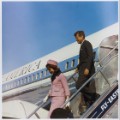




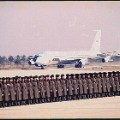


Story highlights
Air Force One SAM 26000 has seen more history than just about any other aircraft
It flew President John F. Kennedy's body from Dallas, flew Nixon to China and carried Queen Elizabeth II
President Lyndon Johnson spoke to reporters aboard the plane while getting dressed
(CNN)There he was, the leader of the free world, President Lyndon Baines Johnson, aboard Air Force One standing in front of reporters, naked as a jaybird.
To be fair, it was a hot, sunny day.
Johnson, who wasn't a shy man, had just finished delivering a stump speech during his 1964 presidential election campaign.
He'd invited White House reporter Frank Cormier and two colleagues to an impromptu news conference in the presidential quarters, according to Cormier's 1977 book, "LBJ: The Way He Was."
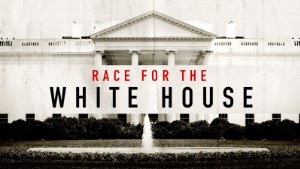
CNN's "Race For The White House," narrated by Kevin Spacey
It's not every day that the president of the United States takes off his shirt and pants while answering your questions about the economy.
As Cormier described it, Johnson "shucked off his underwear." Then, as if nothing unusual were going on, the President continued talking to the reporters while "standing buck naked and waving his towel for emphasis."
Related story: First Air Force One wastes away in desert
No big deal. Just another day on Air Force One.
The plane that was carrying Johnson and the reporters that day was special. "A person could justify that it's the most important historical airplane in the world," Air Force historian Jeff Underwood said in 2013. The Air Force gave it the code name Special Air Mission (SAM) 26000.
Why so historic?
In a nutshell, a lot of history has taken place aboard that airplane.
A president was sworn in aboard it
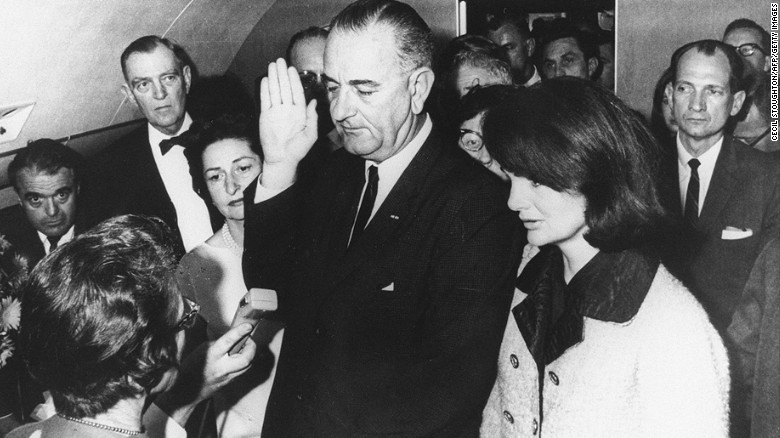
Less than a year before his memorable interview, Johnson had become president aboard the very same airplane.
It was November 22, 1963 -- a date millions of Americans remember well -- when Johnson was sworn in just hours after President John F. Kennedy was assassinated in Dallas.
He was sworn in by U.S. District Judge Sarah T. Hughes, the only woman ever to swear in a U.S. commander in chief.
It flew JFK's body from Dallas to Washington
6 photos: Photos: John F. Kennedy's funeral
John F. Kennedy's funeral – John F. Kennedy's flag-draped casket lies in state in Washington.
Hide Caption
4 of 6
6 photos: Photos: John F. Kennedy's funeral
John F. Kennedy's funeral – A horse-drawn caisson bears the body of President John F. Kennedy into Arlington National Cemetery.
Hide Caption
5 of 6
6 photos: Photos: John F. Kennedy's funeral
John F. Kennedy's funeral – John F. Kennedy's widow, Jacqueline Kennedy, and brother Robert Kennedy attend his funeral at Arlington National Cemetery. See the complete gallery of photos at LIFE.com.
Hide Caption
6 of 6
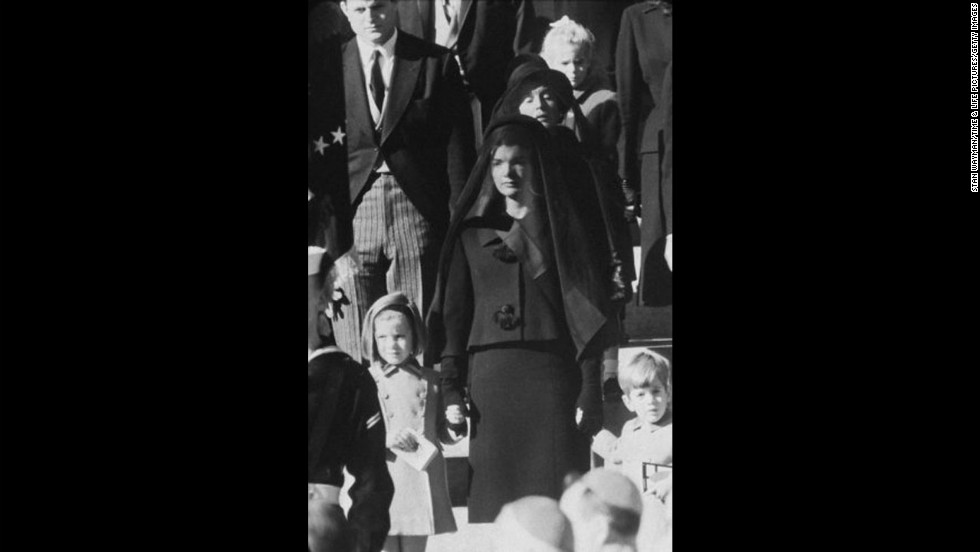
6 photos: Photos: John F. Kennedy's funeral
John F. Kennedy's funeral – On November 22, 1963, President John F. Kennedy was assassinated while in a presidential motorcade in Dallas. Pictured, Kennedy's widow, Jacqueline Kennedy, children, Caroline and John, and mother, Rose Kennedy, behind, wait outside St. Matthew's Cathedral for the procession to the cemetery during his funeral on November 25.
Hide Caption
1 of 6
6 photos: Photos: John F. Kennedy's funeral
John F. Kennedy's funeral – On November 22, 1963, President John F. Kennedy was assassinated while in a presidential motorcade in Dallas. Pictured, Kennedy's widow, Jacqueline Kennedy, children, Caroline and John, and mother, Rose Kennedy, behind, wait outside St. Matthew's Cathedral for the procession to the cemetery during his funeral on November 25.
Hide Caption
2 of 6
6 photos: Photos: John F. Kennedy's funeral
John F. Kennedy's funeral – Kennedy's flag-draped casket lies in state in Washington.
Hide Caption
3 of 6
6 photos: Photos: John F. Kennedy's funeral
John F. Kennedy's funeral – John F. Kennedy's flag-draped casket lies in state in Washington.
Hide Caption
4 of 6
6 photos: Photos: John F. Kennedy's funeral
John F. Kennedy's funeral – A horse-drawn caisson bears the body of President John F. Kennedy into Arlington National Cemetery.
Hide Caption
5 of 6
6 photos: Photos: John F. Kennedy's funeral
John F. Kennedy's funeral – John F. Kennedy's widow, Jacqueline Kennedy, and brother Robert Kennedy attend his funeral at Arlington National Cemetery. See the complete gallery of photos at LIFE.com.
Hide Caption
6 of 6

6 photos: Photos: John F. Kennedy's funeral
John F. Kennedy's funeral – On November 22, 1963, President John F. Kennedy was assassinated while in a presidential motorcade in Dallas. Pictured, Kennedy's widow, Jacqueline Kennedy, children, Caroline and John, and mother, Rose Kennedy, behind, wait outside St. Matthew's Cathedral for the procession to the cemetery during his funeral on November 25.
Hide Caption
1 of 6
6 photos: Photos: John F. Kennedy's funeral
John F. Kennedy's funeral – On November 22, 1963, President John F. Kennedy was assassinated while in a presidential motorcade in Dallas. Pictured, Kennedy's widow, Jacqueline Kennedy, children, Caroline and John, and mother, Rose Kennedy, behind, wait outside St. Matthew's Cathedral for the procession to the cemetery during his funeral on November 25.
Hide Caption
2 of 6
6 photos: Photos: John F. Kennedy's funeral
John F. Kennedy's funeral – Kennedy's flag-draped casket lies in state in Washington.
Hide Caption
3 of 6






With a newly sworn-in President Johnson aboard, Kennedy's widow, Jacqueline, accompanied the former President's body, which was in a casket that had been placed in the rear of the aircraft.
A portion of the plane's wall had to be cut away to make room.
A few days after SAM 26000 landed in Washington, the aircraft performed a high-speed flyover at Kennedy's funeral at Arlington National Cemetery.
It flew Nixon on his historic mission to China
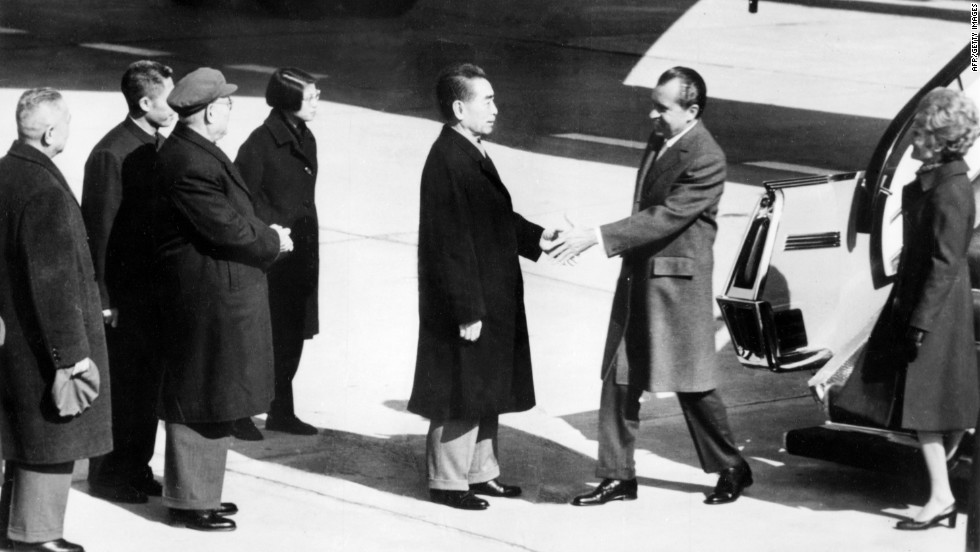
In 1972, the first meeting between leaders of China and the United States opened the door to diplomatic relations between the two nations, eventually giving Washington geopolitical leverage during arms treaty negotiations with the Soviet Union.
It flew three former presidents simultaneously to Egypt
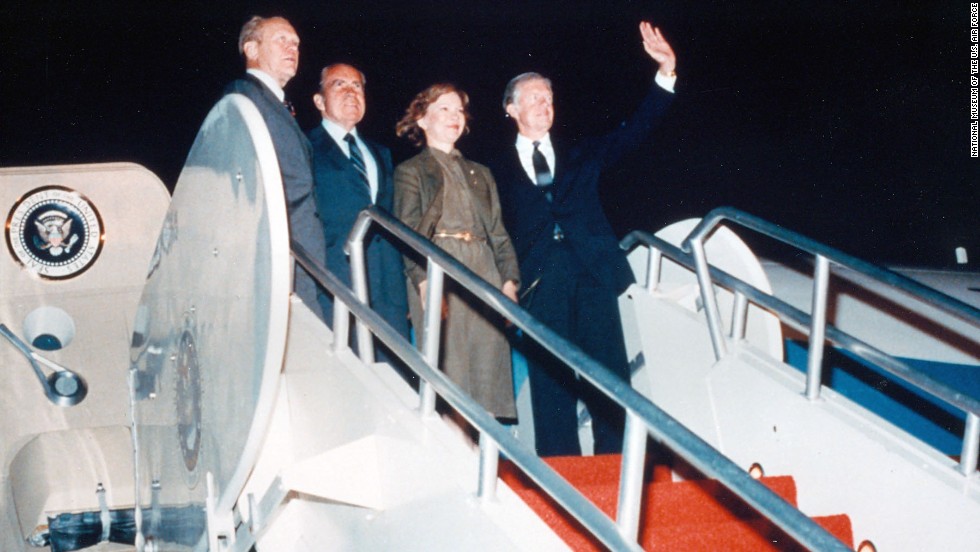
In 1981, SAM 26000 flew former Presidents Nixon, Jimmy Carter and Gerald Ford to the funeral of Egyptian President Anwar Sadat.
They felt "somewhat ill at ease," Carter wrote years later. And they certainly had their reasons -- especially Carter and Ford. Just five years earlier, Carter, a Democrat, had delivered a stinging election defeat to the GOP's Ford. Tension also ran high among staffers aboard the flight. They endured long waits to use the lavatories and got upset about who received bigger cuts of steak at dinner, according to author Ronald Kessler.
Then Nixon "surprisingly eased the tension" with "courtesy, eloquence and charm," Carter revealed in a memoir. Aboard SAM 26000, the two former enemies developed a camaraderie and then a friendship, wrote historian Douglas Brinkley.
Royal visit and presidential deaths
The plane also flew Britain's Queen Elizabeth II around the United States during her visit in 1983. It carried LBJ's body after his death in 1973, and after Nixon's death in 1994, it ferried his casket home to California.
Where you can see it
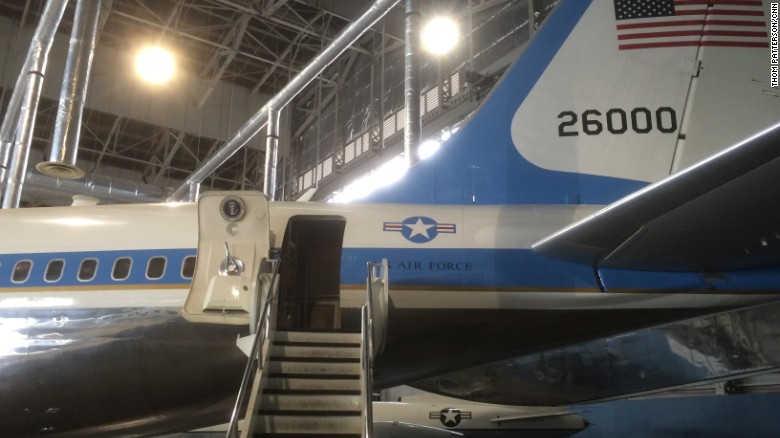
SAM 26000 is on display at the Museum of the U.S. Air Force.
Folks who are used to seeing the president fly on giant 747s might be surprised about the relatively small SAM 26000. It seats only about 40 passengers. A military version of a Boeing 707, it's a narrow-body, single-aisle, four-engine jetliner.
The plane is now on display at the National Museum of the United States Air Force near Dayton, Ohio, and you can walk down the aisle and look through plexiglass to see the office where the commander in chief took phone calls. You can also see the area where White House staffers worked during long flights.
And, yes, you can see the tiny sleeping quarters where LBJ, um, waved "his towel for emphasis" on that hot day in 1964.
15 photos: U.S. Presidents and Air Force One
President Gerald Ford works while aboard Air Force One in 1974.
Hide Caption
8 of 15
15 photos: U.S. Presidents and Air Force One
President Jimmy Carter waves goodbye as he boards a presidential aircraft on his final day in office in 1981.
Hide Caption
9 of 15
15 photos: U.S. Presidents and Air Force One
President Ronald Reagan throws a football toward the press before boarding Air Force One in 1988.
Hide Caption
10 of 15
15 photos: U.S. Presidents and Air Force One
President George H. W. Bush talks with reporters aboard Air Force One in 1990. The Boeing VC-25 -- a military version of the 747-200B -- served as Air Force One for Bush as well as Presidents Bill Clinton, George W. Bush and Barack Obama.
Hide Caption
11 of 15
15 photos: U.S. Presidents and Air Force One
Clinton deplanes Air Force One in Philadelphia in 1996.
Hide Caption
12 of 15
15 photos: U.S. Presidents and Air Force One
President George W. Bush, aboard Air Force One, speaks with Vice President Dick Cheney by phone on September 11, 2001.
Hide Caption
13 of 15
15 photos: U.S. Presidents and Air Force One
Obama steps off Air Force One at Andrews Air Force Base in April.
Hide Caption
14 of 15
15 photos: U.S. Presidents and Air Force One
A customized military version of this Boeing 747-8 will serve future Presidents.
Hide Caption
15 of 15

15 photos: U.S. Presidents and Air Force One
Air Force One flies past an American flag on its way into Daytona Beach, Florida, in 2004. The U.S. Air Force announced Wednesday, January 28, that a customized military version of Boeing's 747-8 will serve as Air Force One for future Presidents. Click through to see the different airplanes that have served as the President's transportation over the years.
Hide Caption
1 of 15
15 photos: U.S. Presidents and Air Force One
The Douglas VC-54C, nicknamed "Sacred Cow," is on display at the National Museum of the United States Air Force, near Dayton, Ohio. Sacred Cow served as President Franklin Roosevelt's official transportation to the Yalta Conference in February 1945.
Hide Caption
2 of 15
15 photos: U.S. Presidents and Air Force One
President Harry Truman's official aircraft, the Independence, served as the presidential plane for almost six years until 1953.
Hide Caption
3 of 15
15 photos: U.S. Presidents and Air Force One
A presidential plane named Columbine III ferried Dwight D. Eisenhower, Britain's Queen Elizabeth II and Prince Philip to Washington in November 1957.
Hide Caption
4 of 15
15 photos: U.S. Presidents and Air Force One
From left, astronaut John Glenn, Vice President Lyndon B. Johnson, and President John F. Kennedy arrive at Cape Canaveral Air Force Station in February 1962. Kennedy was the first president to use a customized Boeing VC-137C as Air Force One. The plane was a military version of the Boeing 707. Code-named "SAM 26000," this jet served presidents for more than three decades.
Hide Caption
5 of 15
15 photos: U.S. Presidents and Air Force One
Following Kennedy's assassination, Johnson was sworn in as the President aboard SAM 26000 -- Special Air Mission, tail number 26000.
Hide Caption
6 of 15
15 photos: U.S. Presidents and Air Force One
With Air Force One in the background, President Richard Nixon delivers a speech at Andrews Air Force Base near Washington after returning from his historic trip to China in February 1972.
Hide Caption
7 of 15
15 photos: U.S. Presidents and Air Force One
President Gerald Ford works while aboard Air Force One in 1974.
Hide Caption
8 of 15
15 photos: U.S. Presidents and Air Force One
President Jimmy Carter waves goodbye as he boards a presidential aircraft on his final day in office in 1981.
Hide Caption
9 of 15
15 photos: U.S. Presidents and Air Force One
President Ronald Reagan throws a football toward the press before boarding Air Force One in 1988.
Hide Caption
10 of 15
15 photos: U.S. Presidents and Air Force One
President George H. W. Bush talks with reporters aboard Air Force One in 1990. The Boeing VC-25 -- a military version of the 747-200B -- served as Air Force One for Bush as well as Presidents Bill Clinton, George W. Bush and Barack Obama.
Hide Caption
11 of 15
15 photos: U.S. Presidents and Air Force One
Clinton deplanes Air Force One in Philadelphia in 1996.
Hide Caption
12 of 15
15 photos: U.S. Presidents and Air Force One
President George W. Bush, aboard Air Force One, speaks with Vice President Dick Cheney by phone on September 11, 2001.
Hide Caption
13 of 15
15 photos: U.S. Presidents and Air Force One
Obama steps off Air Force One at Andrews Air Force Base in April.
Hide Caption
14 of 15
15 photos: U.S. Presidents and Air Force One
A customized military version of this Boeing 747-8 will serve future Presidents.
Hide Caption
15 of 15

15 photos: U.S. Presidents and Air Force One
Air Force One flies past an American flag on its way into Daytona Beach, Florida, in 2004. The U.S. Air Force announced Wednesday, January 28, that a customized military version of Boeing's 747-8 will serve as Air Force One for future Presidents. Click through to see the different airplanes that have served as the President's transportation over the years.
Hide Caption
1 of 15
15 photos: U.S. Presidents and Air Force One
The Douglas VC-54C, nicknamed "Sacred Cow," is on display at the National Museum of the United States Air Force, near Dayton, Ohio. Sacred Cow served as President Franklin Roosevelt's official transportation to the Yalta Conference in February 1945.
Hide Caption
2 of 15
15 photos: U.S. Presidents and Air Force One
President Harry Truman's official aircraft, the Independence, served as the presidential plane for almost six years until 1953.
Hide Caption
3 of 15
15 photos: U.S. Presidents and Air Force One
A presidential plane named Columbine III ferried Dwight D. Eisenhower, Britain's Queen Elizabeth II and Prince Philip to Washington in November 1957.
Hide Caption
4 of 15
15 photos: U.S. Presidents and Air Force One
From left, astronaut John Glenn, Vice President Lyndon B. Johnson, and President John F. Kennedy arrive at Cape Canaveral Air Force Station in February 1962. Kennedy was the first president to use a customized Boeing VC-137C as Air Force One. The plane was a military version of the Boeing 707. Code-named "SAM 26000," this jet served presidents for more than three decades.
Hide Caption
5 of 15
15 photos: U.S. Presidents and Air Force One
Following Kennedy's assassination, Johnson was sworn in as the President aboard SAM 26000 -- Special Air Mission, tail number 26000.
Hide Caption
6 of 15
15 photos: U.S. Presidents and Air Force One
With Air Force One in the background, President Richard Nixon delivers a speech at Andrews Air Force Base near Washington after returning from his historic trip to China in February 1972.
Hide Caption
7 of 15
15 photos: U.S. Presidents and Air Force One
President Gerald Ford works while aboard Air Force One in 1974.
Hide Caption
8 of 15
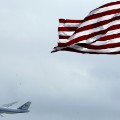

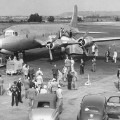
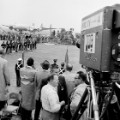
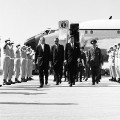
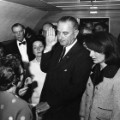
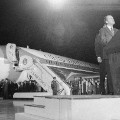
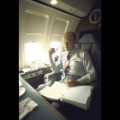
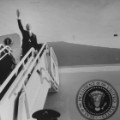
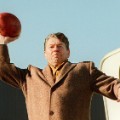
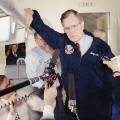
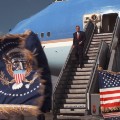
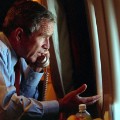
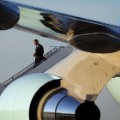
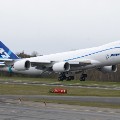
Subscrever:
Mensagens (Atom)


